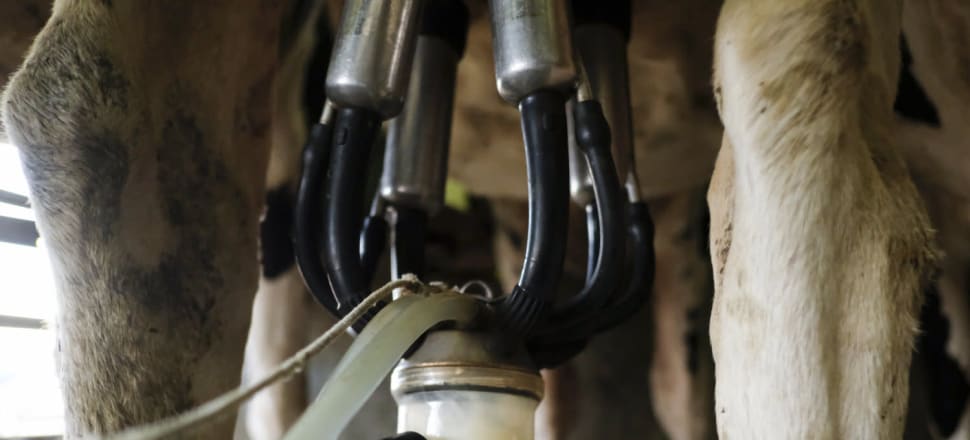
Revisions lowered the September 50-State and 24-State totals 5 million pounds, putting the 50-State total at 18.0 billion pounds, still up 2.3% from September 2019.
October cow numbers totaled 9.39 million head in the 50 states, up 14,000 from September and 43,000 above a year ago. The September total was revised up 10,000 head.
October’s output per cow averaged 1,977 pounds, up 37 pounds from a year ago or 1.9%.
California was up 1.2% from a year ago, thanks to a 30-pound gain per cow offsetting 5,000 fewer cows milked. September output was revised down 34 million pounds, up 2.2% from September 2019, instead of the 3.2% gain originally reported.
Wisconsin was up 1.7% in October, on a 50-pound gain per cow offsetting 9,000 fewer cows.
Idaho was up 2.7%, thanks to 14,000 more cows and 10 pounds more per cow.
Michigan was up 3%, on a 50-pound gain per cow and 3,000 more cows. Minnesota was up 2.5%, on a 60-pound gain per cow offsetting 3,000 less cows. New Mexico was up 1.9%, on a 25-pound gain per cow and 2,000 more cows.
New York was up 1.0%, thanks to a 20-pound gain per cow. Cow numbers were unchanged.
Oregon was down 2.3% on 2,000 fewer cows and a 10-pound loss per cow.
Pennsylvania was up 2.5%, on a 55-pound gain per cow offsetting a loss of 3,000 cows from a year ago.
South Dakota saw the biggest gain, up 12.9%, on 13,000 more cows and 45 more pounds per cow. Texas was up 8.2% on 28,000 more cows and a 65-pound gain per cow.
Washington state was off 0.5% on 2,000 fewer cows, though output per cow was up 5 pounds. Most analysts view the report as bearish to the market.
Culling below 2019
Dairy cow culling crept higher in October, according to the latest Livestock Slaughter report, but was below a year ago. An estimated 258,900 head were sent to slaughter under federal inspection, up 8,500 head or 3.4% from September but 27,200 or 9.5% below October 2019.
A total of 2.56 million head have been culled in the first 10 months of 2020, down 142,100 head or 5.3% from the same period in 2019.
In the week ending Nov. 11, 57,800 dairy cows were sent to slaughter, same as the week before but 4,900 head or 7.8% below that week a year ago.
Huge butter stocks
Butter stocks tumbled in October but remain well above year ago levels. The Agriculture Department’s latest Cold Storage report has the Oct. 31 butter inventory at 300.9 million pounds, down 43.7 million pounds or 12.7% from September, but a still burdensome 65.8 million pounds or 28.0% above October 2019, 16th consecutive month they topped the year ago level.
American type cheese fell to 753.9 million pounds, down 18.4 million pounds or 2.4% from September, but were 10.3 million pounds or 1.4% above a year ago.
The “other” cheese inventory crept to 564.4 million pounds, up 1.7 million pounds or 0.3% from September, but 7.6 million pounds or 1.3% below a year ago.
The total cheese inventory fell to 1.34 billion pounds, down 17.3 million pounds or 1.3% from September, and 3.2 million pounds or 0.2% below October 2019.
Cheese rallies
CME block Cheddar dropped to $1.5975 per pound by Thursday last week, lowest since Aug. 11, but regained 4.75 cents Friday, first gain since Oct. 31, and closed at $1.6450, still down 27.25 cents on the week and 19.75 cents below a year ago. They had plunged $1.1375 in the past three weeks.
The barrels plunged 21 cents last Monday, falling to $1.40, lowest since Aug. 24, but also pushed higher Friday, closing at $1.4225, 18.75 cents lower on the week, and 76.25 cents below a year ago. The barrels lost $1.1075 in three weeks. Seven cars of block were sold last week at the CME and 13 of barrel.
The blocks added 1.50 cents Monday on a trade, as traders anticipated the afternoon’s Cold Storage data, and gained 2 cents Tuesday on a trade, hitting $1.68.
The barrels gave back the 2.25 cents they gained Friday and stayed put Tuesday at $1.40, with 10 cars unloaded on the day, 28 cents below the blocks.
Midwest cheese producers continue to report COVID-related staffing concerns, reports Dairy Market News, though production is running steadily. Milk availability is growing and cheesemakers are reporting notably lower spot milk prices. There was some interest on the cheese buyer side this week, as customers are returning in light of the price declines, but most reports continue to point to buyer hesitancy.
There is concern about more public restrictions due to the pandemic, plus cheese customers do not want extra inventory at the end of the year, says DMN.
Western cheese buyers are seeing more offers for cheese as prices sink. Contacts think markets shifted from active demand to oversupply in a relatively short amount of time and manufacturers and brokers are trying to clear stocks so they don’t lose value. Buyers are not interested unless prices are at lower levels. The challenge for both buyers and sellers is that demand for cheese is lagging. Retail demand is ahead of last year but foodservice sales are weak, government purchases are less than previous rounds, and higher prices have stagnated export opportunities.
Spot butter saw a Friday finish at $1.3450 per pound, down 5.50 cents on the week and 68 cents below a year ago, with 21 cars trading hands on the week.
Monday’s butter backed down another 2.75 cents, with 26 carloads exchanging hands, and lost 0.75 cents Tuesday, dipping to $1.31, lowest CME price since May 8.
Central butter producers report mixed tones on cream availability. Some say offers were generally quiet, others are still receiving cream if they choose to take it. Expectations are pointing to more cream becoming available into early 2021. Food service is not expected to be where it has been in previous years. Retail buying increases have helped allay some of the foodservice loss, but market prices are and have been strained in 2020 compared to previous years.
Cream supplies have been adequate for steady butter production in the West. A surge is anticipated Thanksgiving week as some operations take time off. Orders remain strong for most print accounts as prices edge lower. Recent lockdowns, due to advancing pandemic concerns, are stimulating retail sales. Manufacturers continue to pull heavily on stored butter to meet the strong year-end orders.
Grade A nonfat dry milk closed Friday at $1.0850 per pound, down a quarter-cent on the week and 13.50 cents below a year ago, with 29 sales reported last week.
The powder was off 0.25 cents Monday but crept back up 0.50 cents Tuesday, to $1.0875, with 11 cars sold on the day.
Dry whey fell to 42 cents per pound last Wednesday but closed Friday at 43.75 cents, up 0.75 cents on the week and 9 cents above a year ago on 2 sales for the week.
The whey was unchanged Monday but backed down 0.75 cents Tuesday, to 43 cents per pound.
Class I up $1.83
The Agriculture Department announced the December Federal order Class I base milk price at $19.87 per hundredweight, up $1.83 from November, the highest Class I price since December 2014, and 54 cents above December 2019. That put the 2020 Class I average at $16.91, down from $16.99 in 2019 and compares to $14.84 in 2018.
Have a Happy and Blessed Thanksgiving!

























